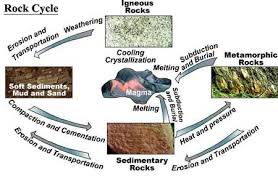Overview
Although the history of human civilization on earth goes back thousands of years, geologic time stretches back over billions of years. During geologic time, even rocks change from one type to another. The slow cycle of change from one rock type to another is called the rock cycle.
The Rock Cycle
Melted magma hardens and cools to form igneous rock, some igneous rock weathers to sediment, and some sediment hardens to form sedimentary rock. Further, some types of igneous and sedimentary rock metamorphose to form types of metamorphic rock. The rock cycle just means that rocks do not remain the same type. Sedimentary rocks and metamorphic rocks can also weather, and any type of rock can melt and harden if it is subjected to high enough temperature and pressure. Planet Earth is still young, and geologists have found evidence that it melted soon after its formation, so most of its rock in the crust is still igneous.
Erosion
Sediment is produced from rock by the action of wind, water, glaciers, and gravity. Over time, rivers can cut through stone, forming canyons. While the river flows swiftly, it carries the sediment along with it. Eventually, a slow river deposits sediment in stream beds, flood plains and deltas. Wind can sandblast even the hardest granitic mountains. Glaciers carry and deposit all sizes of sediment. Rocks can roll off cliffs and mountains, creating an avalanche.
Lithification
Loose sediment becomes compacted into hard rock by processes of lithification. A few grains of sand are very light, but large amounts of sand are heavy enough to compact into rock over geologic time. Also, chemicals dissolved in water act like cement to glue individual grains together into rock. Sedimentary beds actually show lines and ripples that show when sediment was deposited.
Metamorphic Action
The outer crust of the Earth is made up of tectonic plates that move constantly, burying some rocks and uncovering new formations. Usually this process moves very slowly, across eons of time. Buried rocks become hotter, melting if they become hot enough. Chemicals in underground water can react with materials, creating new compounds. Some rocks develop layers of minerals, such as gneiss, while others do not. Metals can gather within fractures in rock, collecting to form veins. Other formations that are uncovered can weather, leaving sediment.
Interested in science tutoring services? Learn more about how we are assisting thousands of students each academic year.
<span class=”tutorOrange”>SchoolTutoring Academy</span>is the premier educational services company for K-12 and college students. We offer tutoring programs for students in K-12, AP classes, and college. To learn more about how we help parents and students in Salina, KS: visit Tutoring in Salina, KS




